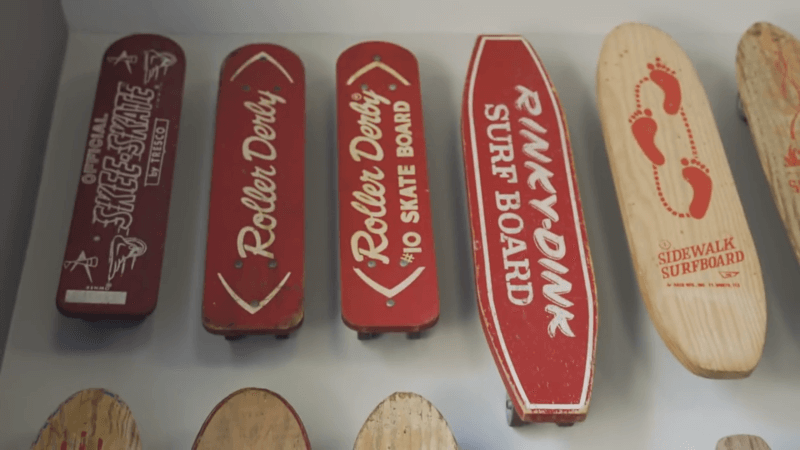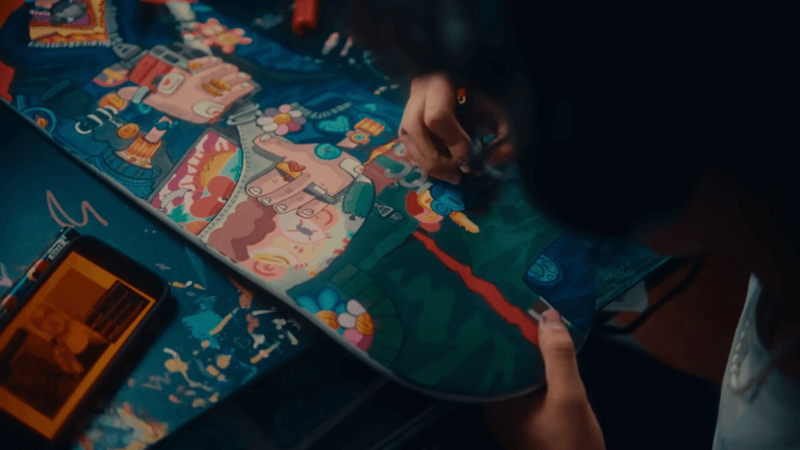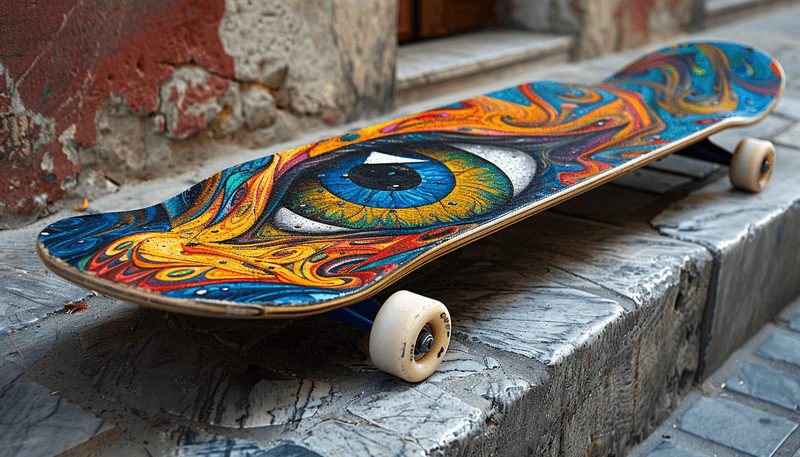No products in the cart.
Blog
Where to Buy Vintage Skateboards Exploring Nostalgia
When exploring where to buy vintage skateboards, enthusiasts and collectors delve into a world rich with history and nostalgia. This guide will help you navigate the top sources for purchasing vintage skateboards, ensuring you can add a valuable piece of skateboarding history to your collection.
Definition of Vintage Skateboards and Decks
Vintage skateboards and decks are from the past, usually from the 1960s to the 1990s. Collectors and fans love these old skateboards because they show how skateboarding has changed over the years. The deck is the flat board you stand on, and vintage ones were made with different materials and styles that were popular at the time. Having a vintage skateboard is like having a piece of skateboarding history.

Key Features of Vintage Decks
- Material and Build: Vintage decks were often made from solid wood, usually maple, which made them strong and flexible. Some old boards were made from fiberglass or plastic.
- Shape and Size: The shape and size of vintage decks varied a lot. In the 60s, decks were narrow and flat. In the 70s, they got wider with a slight curve. By the 80s, decks had a more noticeable curve and raised ends, making tricks easier.
- Graphics and Art: The artwork on vintage decks is a big part of their appeal. Many had bold, colorful designs that were often hand-drawn. These graphics are a big reason why collectors love them.
- Truck Mounting: The trucks (the metal parts that hold the wheels) on vintage boards were often placed differently than on modern boards, affecting how the board rides and turns.
- Nostalgic Value: Besides their look and build, vintage decks remind people of the early days of skateboarding and are often linked to famous skaters and memorable moments.
Differences Between Modern and Vintage Decks
- Technology and Materials: Modern decks are made with advanced techniques and materials like carbon fiber, making them lighter and stronger than vintage ones.
- Design and Shape: Today’s decks are precisely designed with deep curves and specific shapes for different skating styles, like street or park skating. Vintage decks were more general and less specialized.
- Graphics and Production: Modern decks have high-quality, detailed graphics made with advanced printing methods. Vintage decks, while simpler, are loved for their unique, often hand-crafted artwork.
- Performance and Durability: Modern decks are built to handle the tough demands of today’s skating, with better shock absorption and strength. Vintage decks were durable for their time but might not hold up as well to modern skating.
- Nostalgia vs. Functionality: Vintage decks are often valued for their nostalgic appeal and collectibility, while modern decks are prized for their performance and advanced features.
Where to Buy Vintage Skateboards
Finding the perfect vintage skateboard can be an exciting and rewarding experience. Whether you’re a collector, a nostalgic skater, or simply an enthusiast, there are numerous avenues to explore when hunting for these classic pieces. Here’s a detailed guide on where to buy vintage skateboards:
Online Marketplaces
- eBay: eBay is one of the most popular places to buy vintage skateboards. You can find a wide variety of boards from different eras, often at competitive prices. Just be sure to check the seller’s ratings and read the descriptions carefully.
- Etsy: Known for handmade and unique items, Etsy also has a good selection of vintage skateboards. Many sellers specialize in retro items, so you might find some rare gems.
- Craigslist: Craigslist can be a hit or miss, but it’s worth checking out. Sometimes people sell old skateboards they find in their garage at very reasonable prices.
- Specialty Websites: Some websites specialize in vintage skateboards and gear. These sites often have a more curated selection and can offer expert advice on your purchase.
Skateboard Conventions and Trade Shows
- Local Skateboard Events: Many cities host skateboard conventions or trade shows where collectors and sellers come together. These events are great for finding vintage skateboards and connecting with other enthusiasts.
- Collector Shows: There are specific shows dedicated to vintage skateboards and gear. These events attract serious collectors and sellers, so you’re likely to find high-quality items.
- Skate Shops: Some specialty skate shops hold events or have sections dedicated to vintage boards. Visiting these shops can give you a chance to see and feel the boards in person before buying.
Social Media Groups and Forums
- Facebook Groups: There are many Facebook groups dedicated to buying and selling vintage skateboards. Joining these groups can connect you with sellers and other collectors who can offer advice and insights.
- Reddit: Subreddits like r/OldSchoolSkate and r/SkateboardCollecting are great places to find vintage skateboards. You can also ask for recommendations and advice from the community.
- Forums: Online forums like Skull and Bones Skateboards have sections for buying and selling vintage boards. These forums are often full of knowledgeable enthusiasts who can help you find what you’re looking for.
- Instagram: Many collectors and sellers use Instagram to showcase and sell their vintage skateboards. Searching hashtags like #vintageskateboards can lead you to individual sellers or shops.
How to Choose the Right Vintage Skateboard Deck
Choosing the right vintage skateboard deck involves understanding the era and style you’re interested in, checking the deck’s condition for minimal wear and tear, verifying its authenticity, considering the size and shape based on your riding style, and appreciating the graphics and aesthetics. Additionally, setting a budget, deciding whether you want the deck for riding or display, and consulting the vintage skateboarding community can guide you towards finding a deck that meets both your functional and sentimental needs.

Analyzing Deck Shape and Size
Deck Shape
- Era-Specific Shapes: Different eras have distinct shapes. The 60s are narrow and flat, the 70s are wider with a slight curve, and the 80s have pronounced concaves and kicktails.
- Personal Preference: Choose a shape that suits your style—wider boards for cruising and stability, narrower ones for tricks and agility.
Deck Size
- Width: Vintage decks range from 6 to over 10 inches wide. Wider decks are stable and great for pool or ramp skating; narrower decks are lighter and better for street skating.
- Length: Longer decks offer stability and a smoother ride, while shorter decks are easier to flip and spin.
Checking for Authenticity and Brand Reputation
Authenticity
- Research: Know the common designs, materials, and graphics of the era you’re interested in.
- Serial Numbers and Markings: Check for identifiable features like logos or serial numbers.
- Condition: Ensure the board is in good condition without major repairs or damage.
Brand Reputation
- Recognized Brands: Brands like Powell Peralta, Santa Cruz, and Vision are known for quality.
- Collector Value: Established brands often have higher value. Research the most sought-after models.
- Community Feedback: Engage with online groups and forums for insights and advice.
Visit wipiskate to get your unique personalized skateboard deck today.
Conclusion
Knowing where to buy vintage skateboards is essential for collectors and enthusiasts eager to explore the rich history of skateboarding. These relics from the 1960s to the 1990s not only highlight the evolution of the sport but also capture the cultural and artistic trends of their times. Collectors and enthusiasts cherish vintage boards for their unique materials, distinctive shapes, and iconic graphics.
I am Jasper Thorn, a man passionate about skateboarding. My heart does kickflips and ollies with the rhythm of the wheels on concrete. Every trick, every grind, and every flip tells a story of adrenaline and freedom. I’m always out there, turning every skatepark into my playground, painting it with my awesome moves.


